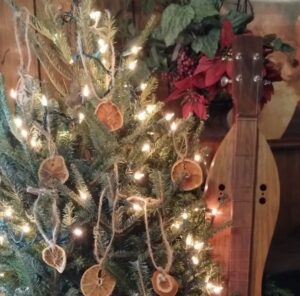Jamming after the Holidays: Change Your… And What About the Seikilos Epitaph


Regina Garson Blogging: Things seemed to be getting back to normal with my first mountain dulcimer jam after the holidays. It was with the folks at Send in the Music, via Zoom. The thing is, I hadn’t touched that instrument since before Christmas, and I soon realized that I must have left my tuner on. It was dead as a doornail.
Of course, I had a set of every battery imaginable, except the AAAs I needed. Not to be undone, I had heard that you could download tuner apps on your cell phone, so I thought I’d try that. I found Tuner – Pitched, which seemed to be a good app. It does everything a good tuner should, but I still wasn’t getting anywhere.
My poor dulcimer sounded worse with every turn of a tuning peg. I finally found another old tuner that I had in a drawer, and I did find a battery to fit that one. It didn’t help either though. I still wasn’t getting anywhere, so I thought I’d give it a try on relative pitch. Instead of using a tuner, you just tune the strings relative to the sound of each other. A lot of acoustic guitar players tune like this, but nope. My poor dulcimer was sounding worse with every single turn of a tuning peg.
Since all of this was happening during a weekly Send in the Music Jam session, it didn’t matter too much that I was spending so much time on the tuning. I just wasn’t getting a lot of playing done.
All was not lost though, they always have an amazing guest at the Send in the Music Jam sessions. That week, it was Butch Ross, who can play rock and roll on the mountain dulcimer, if you can even imagine such a combination of music and instruments. So, I turned Butch up loud. He’s from Chattanooga, Tennessee. Check out his YouTube video, yep, he’s good.
Meanwhile, back to my tuning issues. I started chalking up my strings, thinking the chalk would surely help tighten those strings. I use plain old chalkboard chalk, and it does frequently help, but not this time. My strings were shot. I really should have changed them a year ago.
It is not that I can’t change them, it is just that I don’t like to change them, which is how they ended up in this kind of shape. They were usable until a change in the weather and a few weeks of total neglect did them in. Don’t be like me. Treat your instrument right and change your strings every now and then, or at least once a year. You can easily go on YouTube and get instructions on how to change your dulcimer strings.
Although one may wonder, I did not abandon the jam, and I even found a set of strings that I should have blessed my poor dulcimer with a long time ago. See above about changing them once a year.

Despite my obvious deficit, the jam session continued to get better and better. Adding amazement on top of amazement, on the very last song, Pat Clark, the leader, treated us with a mountain dulcimer rendition, along with the tabs, of the Seikilos Epitaph, which is the oldest known music composition that is actually written out in music notation. When it comes to music, the older something is, the more likely I am to end up totally enamored, and that one had me.
The Seikilos Epitaph is the oldest known artifact of music notation in existence today. The piece is inscribed on a marble column that was found in the ancient settlement of Tralles in western Anatolia, which is currently the city of Aydın, Turkey. The original notation can be seen in the National Museum of Denmark (Wikipedia).
Being as I still hadn’t got my strings changed, after the session, I printed out the mountain dulcimer tabbed rendition of Seikilos Epitaph and started shoving things around in the living room, so I could at least get to the keyboard, which had been buried in the process of the garage door renovations over the summer. Details. Details. I wanted to know more about that song. I found a YouTube version or two that attempted various renditions, and yes I was in love with the Seikilos Epitaph too. The following is an attempt at an original interpretation.

Among other, I’m including links to the various mentioned, so you can check it all out and see why I find these online jam sessions so exciting. Much of this started during the Covid Pandemic when not much of anybody could get out and about, but they continued long afterwards because there are a whole lot of folks who don’t get out a lot anyway. There are others who show up simply because they love the mountain dulcimer. Thus, the virtual online mountain dulcimer community was born. If you have other of interest, please share it in the comments.
Send in the Music is directed by Pat Clark, PsyD. It is a growing, thriving community of mountain dulcimer enthusiasts. In response to the Covid Crisis, Pat started offering free, weekly music jams in March 2020. The jams continue to this day. Click the Send in the Music link if you have an interest or would like to join in too. You can find sign-in information and watch videos of some of the past jam sessions on the website.
Seikilos Epitaph: Wikipedia has more information on the Seikilos Epitaph. I got the picture there.
The First National (virtual) Dulcimer Orchestra may also be of interest. It is directed by Judy and Kirk House. They rehearse weekly via Zoom and perform live at events throughout the year.
QuaranTUNE: A virtual online dulcimer festival, which also comes together via Zoom. The QuaranTUNE Virtual Dulcimer Fest was established to provide relief and connection for musicians during the “lock-down” of early 2020. It continues to host live-streamed events online. Workshops, concerts, and jams are affordable and available to anyone, anywhere in the world.
How to Change Dulcimer Strings: Bing Futch, who is well-known in the mountain dulcimer community, has a good YouTube video that will walk you through what you need to know about changing your strings.
Tuner – Pitched: Tuning apps are available for download on your cell phone. They work just fine. This one is for androids.
Zoom: If you’ve never used Zoom before, you are going to need it to participate in the online jams. It is a software application that allows you to have meetings online. It can also be a lot of fun for things like getting together with other musicians to jam. It is not hard to learn to use, but it has a little bit of a learning curve. It is free to download, so it doesn’t cost you a thing to join in with these online jams.






https://mazda-demio.ru/forums/index.php?autocom=gallery&req=si&img=6566
https://hrv-club.ru/forums/index.php?autocom=gallery&req=si&img=7118
https://mazda-demio.ru/forums/index.php?autocom=gallery&req=si&img=6382
https://mazda-demio.ru/forums/index.php?autocom=gallery&req=si&img=6629
https://honda-fit.ru/forums/index.php?autocom=gallery&req=si&img=7038